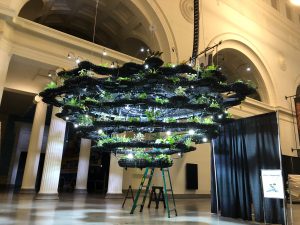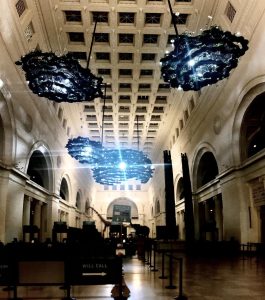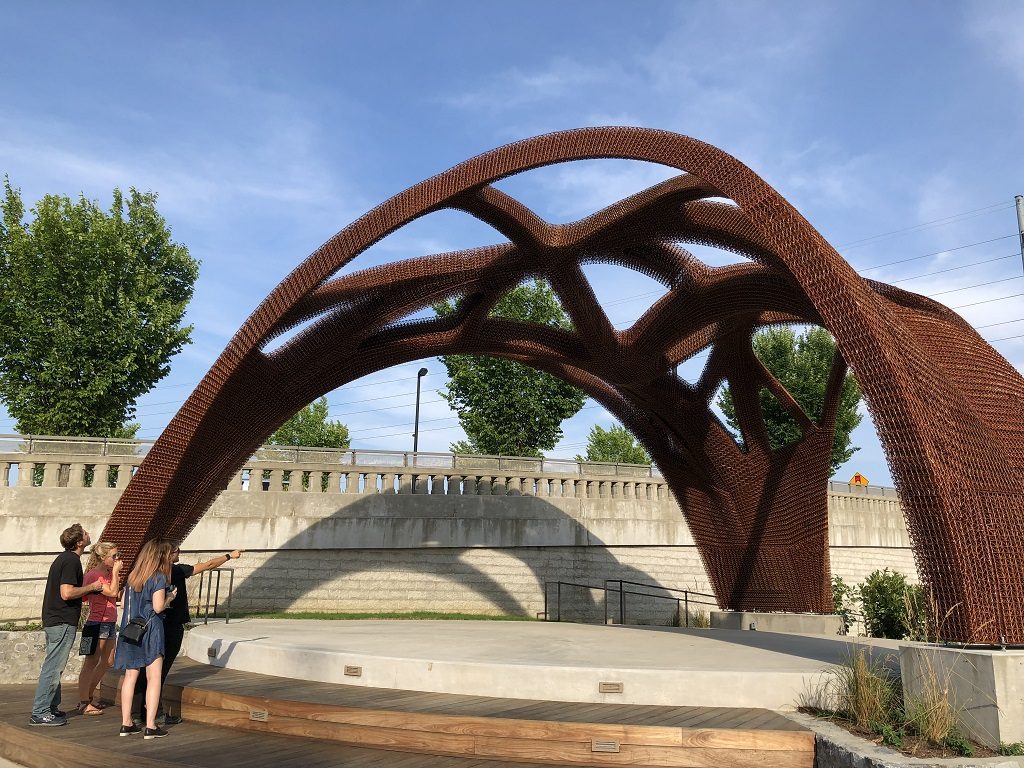 Branch Technology has been on the radar for a few years, since it introduced its patented Cellular Fabrication, or C-Fab, technology. The company’s motto is “Build Like Nature,” and it takes inspiration from the way that nature fabricates to create its strong walls. Its 3D printer utilizes a large robotic arm to build freeform in open space, which allows it to create massive structures such as buildings.
Branch Technology has been on the radar for a few years, since it introduced its patented Cellular Fabrication, or C-Fab, technology. The company’s motto is “Build Like Nature,” and it takes inspiration from the way that nature fabricates to create its strong walls. Its 3D printer utilizes a large robotic arm to build freeform in open space, which allows it to create massive structures such as buildings.
Branch Technology has worked with Techmer PM, a manufacturer of polymer colorants and additives, in the past; the two companies teamed up for the NASA 3D Printed Habitat Challenge and were among the winners in more than one round. Now Branch and Techmer have worked together again for a new pair of projects that demonstrate both the strength of Techmer PM’s materials and the effectiveness of Branch Technology’s building methods.
The latest project is an outdoor band shell in Nashville that measures 42 feet in diameter and is more than 19 feet tall. According to Techmer PM, it’s the largest free-form 3D printed structure in North America. The shell is made up of 36 parts, is more than 18 feet long and fills a volume of 61.5 cubic feet. The project, called One City, involved Branch Technology 3D printing its longest unsupported component yet – a 42-foot-long span that gains its strength from optimized geometry and requires no structural steel.
“The pavilion at OneCity embodies the potentials of large-scale 3D printing. It represents an intersection of design freedom, structural optimization and resource stewardship,” Melody Rees, Designer, Project Management for Branch Technology, told 3DPrint.com.
The band shell is 3D printed from Techmer PM’s Electrafil material, a carbon fiber-reinforced engineering plastic that is both lightweight and high-strength.
“Electrafil provides the highest strength and stiffness performance available in thermoplastic compounds, and those were the most important properties for this project,” said Alan Franc, Product Development Manager for Techmer PM.
 Another recent project by the two companies is called Nature Clouds and was created for the Chicago Field Museum of Natural History’s 125th anniversary. According to Techmer, it’s the first free-form hanging garden installation created through 3D printing; the “clouds” are actually four hanging gardens comprising 3,940 pounds of 3D printed material and steel. They support vegetation, hydroponics, lighting, theatrical fog and sound equipment for a combined weight of 12,270 pounds. Each of the clouds can be raised or lowered if needed. They are part of a larger installation that includes several life-size dinosaur installations.
Another recent project by the two companies is called Nature Clouds and was created for the Chicago Field Museum of Natural History’s 125th anniversary. According to Techmer, it’s the first free-form hanging garden installation created through 3D printing; the “clouds” are actually four hanging gardens comprising 3,940 pounds of 3D printed material and steel. They support vegetation, hydroponics, lighting, theatrical fog and sound equipment for a combined weight of 12,270 pounds. Each of the clouds can be raised or lowered if needed. They are part of a larger installation that includes several life-size dinosaur installations.
Branch Technology used a biopolymer formulated by Techmer PM to 3D print the structures.
“We created a compound specifically for the Field Museum’s Nature Clouds to meet their requirements for strength, flammability, and bio‐sourced resin,” said Franc.
 Nature Clouds’ total volume is 756 cubic feet, with 279 total parts. The project was created as a kit of repeating parts capable of supporting more than 1,000 plants and plant life systems.
Nature Clouds’ total volume is 756 cubic feet, with 279 total parts. The project was created as a kit of repeating parts capable of supporting more than 1,000 plants and plant life systems.
“Typical construction methods are constraining,” said Branch Technology founder and CEO Platt Boyd. “Custom complex form is prohibitively expensive and often inconceivable to manufacture. With C‐Fab, cost‐effective design freedom is democratized for all.”
C-Fab technology uses industrial robotics, carbon composite materials, and sophisticated algorithms to 3D print open-cell structures. It prints volumes as cellular matrices, which sets it apart from other 3D printed construction technologies, and uses a patented 3D printing head attached to a Kuka Robotics arm. The arm travels along a horizontal track, creating a build volume of 3,000 cubic feet. The process can 3D print components that are 8′ x 12′ x 30′, and individual components can be combined for virtually unlimited-size structures. It can also print with a wide variety of materials, many of those which have been supplied by Techmer PM.
“Branch Technology AM print-in-air process is unique. It’s capable of using various resin types and compounds but like most 3D printers, optimizing the material viscosity, flow rate, and crystallization rates are important factors for a successful print,” Tom Drye, VP Emerging Markets and Innovations for Techmer PM, explained to 3DPrint.com. “Techmer PM gathers necessary information up-front on the application: end-use requirements, print rate, and cooling speeds then designs a material to match those needs. Specialty compounds based on: ASA, ABS, PA12, PC, PETG, and others have been successful with the Branch Technology print process. Techmer’s 3D material portfolio and expertise extends broadly amongst the many differing printer types. It’s anticipated many could be customized to work on the Branch process in addition to those already listed.”
As 3D printed construction matures, it’s fascinating to see the different types of processes that emerge from different companies. Branch Technology doesn’t claim to be the fastest, but that’s refreshing in an atmosphere of competitors each claiming they can put up a 3D printed house faster than anyone else. Branch Technology, with help from Techmer PM, has certainly created an interesting variety of structures, showing off the versatility of its technology.
Discuss this and other 3D printing topics at 3DPrintBoard.com or share your thoughts below.
[Images provided by Techmer PM]
Subscribe to Our Email Newsletter
Stay up-to-date on all the latest news from the 3D printing industry and receive information and offers from third party vendors.
You May Also Like
Further Understanding of 3D Printing Design at ADDITIV Design World
ADDITIV is back once again! This time, the virtual platform for additive manufacturing will be holding the first-ever edition of ADDITIV Design World on May 23rd from 9:00 AM –...
3D Printer Maker EVO-tech Reborn as NEVO3D — Once More With Feeling
EVO-tech was a 3D printing service and original equipment manufacturer established in 2013 and based in Schörfling am Attersee, Austria. The company produced high-quality material extrusion systems featuring linear bearings,...
3D Systems Brings 3D Printed PEEK Cranial Implant to the U.S. with FDA Clearance
For more than 10 years, 3D Systems (NYSE:DDD) has worked hand-in-hand with surgeons to plan over 150,000 patient-specific cases, and develop more than two million instruments and implants from its...
CDFAM Returns to Berlin for Second Annual Symposium
The second CDFAM Computational Design Symposium is scheduled for May 7-8, 2024, in Berlin, and will convene leading experts in computational design across all scales. Building upon the first event...

































